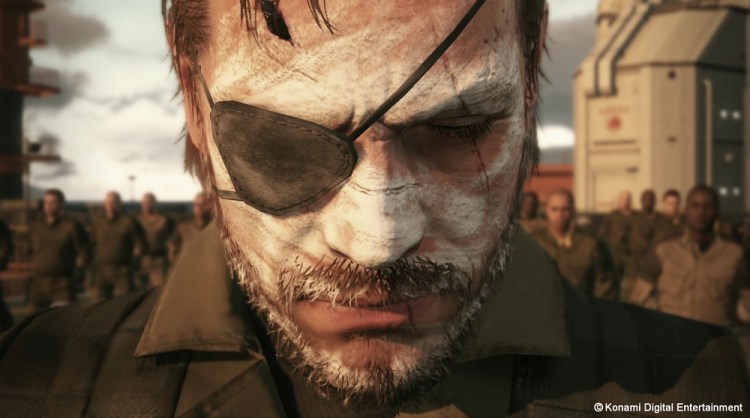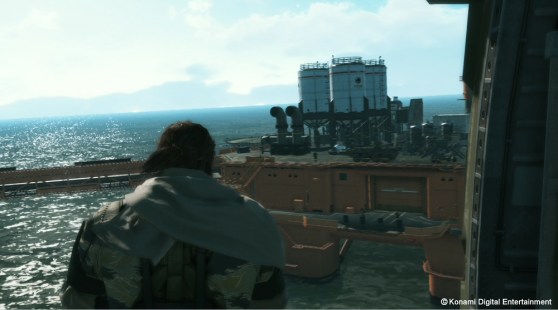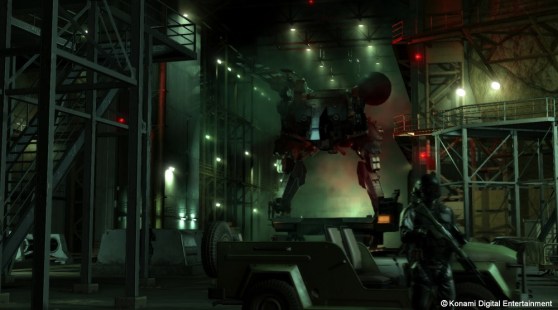LOS ANGELES — Hideo Kojima has been making Metal Gear video games for decades (some more movie-like than others), but now he wants to give players more choice. In his latest Metal Gear Solid V: The Phantom Pain, his team at Kojima Productions has created a kind of limited open world.
The player goes on missions and makes choices. But they can also complete those missions in any way. For instance, in a demo at the giant Electronic Entertainment Expo tradeshow, we saw that you could approach a village from any direction, day or night, and figure out how to rescue a hostage without drawing too many enemies. You can enlist the support of a lot of tech gear, but the outcome of the mission is linear.
I saw a demo of a level of Metal Gear Solid: The Phantom Pain and interviewed Kojima afterward in a media roundtable. Here’s an edited transcript of our conversation.
Question: In the demo we just watched, they talked a lot about revenge, recovery, pain, things like that. And then, obviously, the demo begins with Snake’s return as Big Boss. I was wondering if you can speak to where Snake is on his personal journey where Phantom Pain begins? And perhaps if the design mirrors the idea of Snake becoming something new, in the open-world nature of the game?
Kojima: The game starts in 1984. The end of the game everyone knows – it’s Big Boss creating Outer Heaven. For this game, I want to go along with the player to see how Big Boss gets there. Everyone knows that Big Boss becomes Solid Snake’s enemy, the villain of the story. This is something very difficult. I’m trying to make the player become the bad guy, the villain, but at the same time balance it so that the player understands why this happening. They see where all this is coming from.
Gameplay-wise, I don’t want people to say, “I don’t want to become the bad guy. I’m done with this.” I have to keep some heroism in this character. Maybe it’s like what happens with Walter in Breaking Bad. You watch how this character becomes a bad guy, but you understand where he’s coming from. By watching that process and playing through this process, we want people to understand what’s going on. There’s this double balance, where you don’t want the character to go all the way in one direction, but at the same time, you want them to get their revenge. This is something I’m putting a lot of emphasis on – how to strike this balance and make this in the right way.
Question: You’ve been working in the industry for more than 20 years. I’m curious to know how your approach to development has evolved over the years.
Kojima: More than the approach, I’m working now on high-end triple-A games. It’s somewhat like the equivalent of a Hollywood blockbuster movie, where there’s a huge risk involved, a huge budget, and a high return if it pans out. I want to use a lot of technology, but when you use more technology you need more of a budget, and when you need more budget, it’s more difficult to put more authorship of your own into it, to use a unique approach. The relationship with the marketing department is more difficult. As a creator, it’s become more difficult. This is my challenge right now, to keep creating great things with my own authorship while still creating a triple-A game.
Question: The games in the series have always made some kind of social commentary on what’s happening in the real world. I wonder, when you approach a new story in the Metal Gear franchise, do you try to identify something that’s happening in the real world and put your characters in that situation? Or do you develop these characters and see where they progress throughout this entire story that’s been going for so long?
Kojima: This is a question I get asked a lot. It ties into the question of, what is authorship. When an author has a very unique or specific input, whether it’s intentional or unintentional, the era that person lives in, their environment where they live, is reflected there. It can be a movie about aliens, a game about zombies, whatever it is. If there’s an authorship in there, the time and place of the author will be reflected there.
Sometimes you have these blockbuster titles where anyone could direct it and it’d still taste the same. The product, the feeling will be the same. I believe there has to be some authorship, though, something that reflects my feelings. As far as how I create games, I’m just reflecting what I feel, the things I have in my mind. I put those out there. Some of the things that I’m going through, the things that surround me, might be reflected there. But for me, it’s a natural process. I just reflect what I feel into the game.
For example, Batman movies have been out there forever. There’s a lot of Batman movies. This element that is Batman that remains unchanged. However, the theme around him is constantly changing. Dark Knight came out after 9/11. You can understand that when you watch the movie, because there’s some authorship in there. You understand what era the people who created this were going through. You can say, “OK, this touches on this topic, so it must be from this time and place.”
When people ask me about this, it seems very natural. Actually, I’m worried, because if this doesn’t happen in many games, it could be because they’re being created systematically. Whether you want it or not, people are creative. If many triple-A titles don’t have this, it means there’s a lack of authorship in games. I don’t think that’s positive.
Getting a little bit off-topic here, I just watched the new Godzilla movie. In order to watch that, I’ve been watching the best Godzilla movies from the past 60 years. There was this movie where Godzilla fights Hedorah, Godzilla versus the Smog Monster. Hedorah is this monster that was born from trash and pollution. Just by watching that, I can remember the time in Japan when we had huge environmental problems. It reflects and depicts the era where it was created.
Of course, not all games can be like this or even should be like this. But if there aren’t any games that reflect their times, that’s not a good thing. A creative element should go into this.
Question: After more than 20 years making games, you’re making a first step into open-world design. I’d like to hear your reflections on the place of this new Metal Gear in the advancement of the video game media as a whole.
Kojima: I think of two things. First, Metal Gear was originally a very simple game. You infiltrate somewhere, you accomplish a mission, and you get out. I’ve tried to put this in my games over these 20-plus years. Originally, a huge part of the fun is just looking at the map and thinking, “How do I get in here? Would daytime be better, or nighttime? What route should I take?” That was a huge part of the fun of the game, and it’s something I’ve been using in all my games so far. It’s an element I’m definitely trying to put in this game.
Also, more than 20 years ago, action games didn’t have stories. I tried to relate a story through cutscenes and other elements. Nowadays, we have a lot of linear games that relate stories that way, so I’m trying to do something different. I’m trying to focus on keeping the player’s freedom, and at the same time being able to relate a story. This is my biggest focus right now – how to tell a story without taking away the freedom the player should have.
Question: Did you visit Afghanistan at all in pre-production to get a feel for the environment? How does recent history there, over the last 50 years, tie into the themes of the game?




